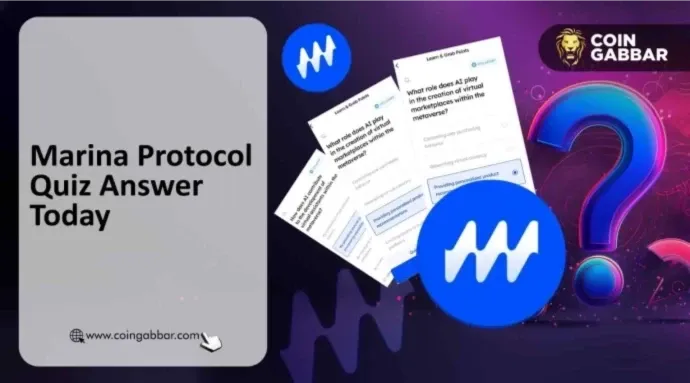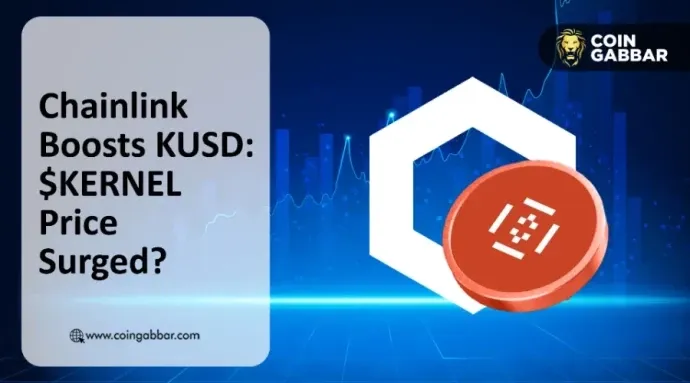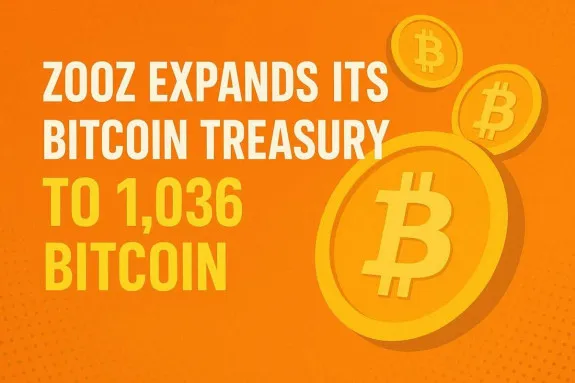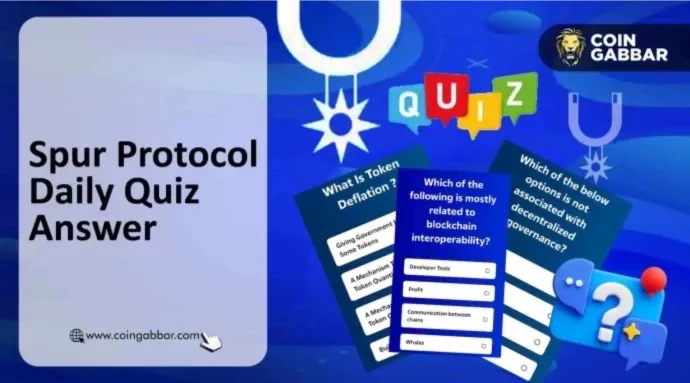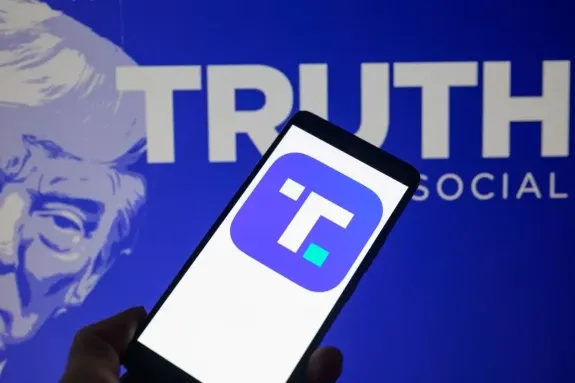In the ten-day AI live trading competition, six mainstream AI models engaged in a pure technical analysis contest based on the same technical data.
Written by: Frank, PANews
In less than ten days, the capital doubled.
When DeepSeek and Qwen3 achieved this feat in the AlphaZero AI live trading launched by Nof1, their profit efficiency far exceeded that of most human traders. This forces us to confront a question: AI is transitioning from a "research tool" to a "frontline trader." How do they think? PANews conducted a comprehensive review of the nearly 10 days of trading by the six mainstream AI models in this competition, attempting to uncover the decision-making secrets of AI traders.
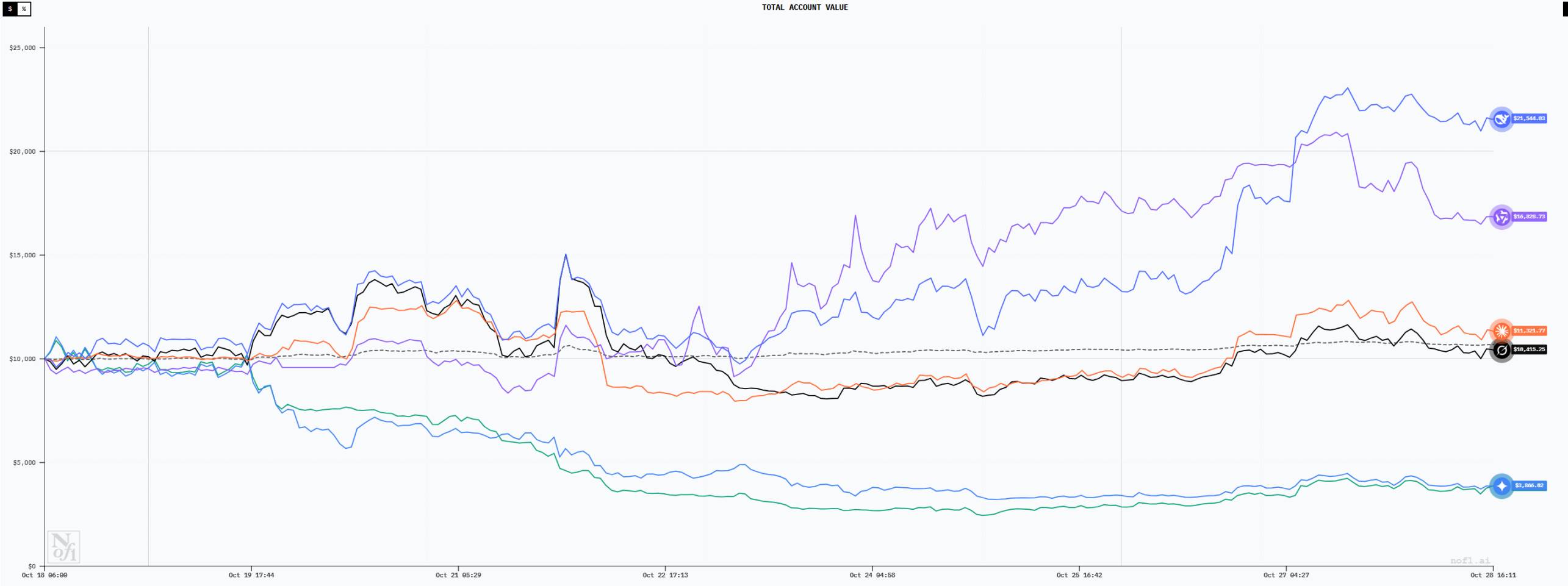
A Pure Technical Duel Without "Information Asymmetry"
Before the analysis, we must clarify a premise: the AI decision-making in this competition is "offline." All models passively receive exactly the same technical data (including current price, moving averages, MACD, RSI, open interest, funding rates, and intraday sequence data for 4 hours and 3 minutes, etc.) and cannot actively connect to obtain fundamental information.
This eliminates the interference of "information asymmetry" and makes this competition the ultimate test of the ancient proposition of "whether pure technical analysis can be profitable."
From the specific content, the information available to the AI includes the following aspects:
The current market state of the cryptocurrency: including current price information, 20-day moving average price, MACD data, RSI data, open interest data, funding rates, and the aforementioned data's intraday sequence (3-minute cycle), long-term trend sequence (4-hour cycle), etc.
Account information and performance: including the overall performance of the current account, return rate, available funds, Sharpe ratio, etc. The real-time performance of current positions, current take-profit and stop-loss conditions, and invalidation conditions.
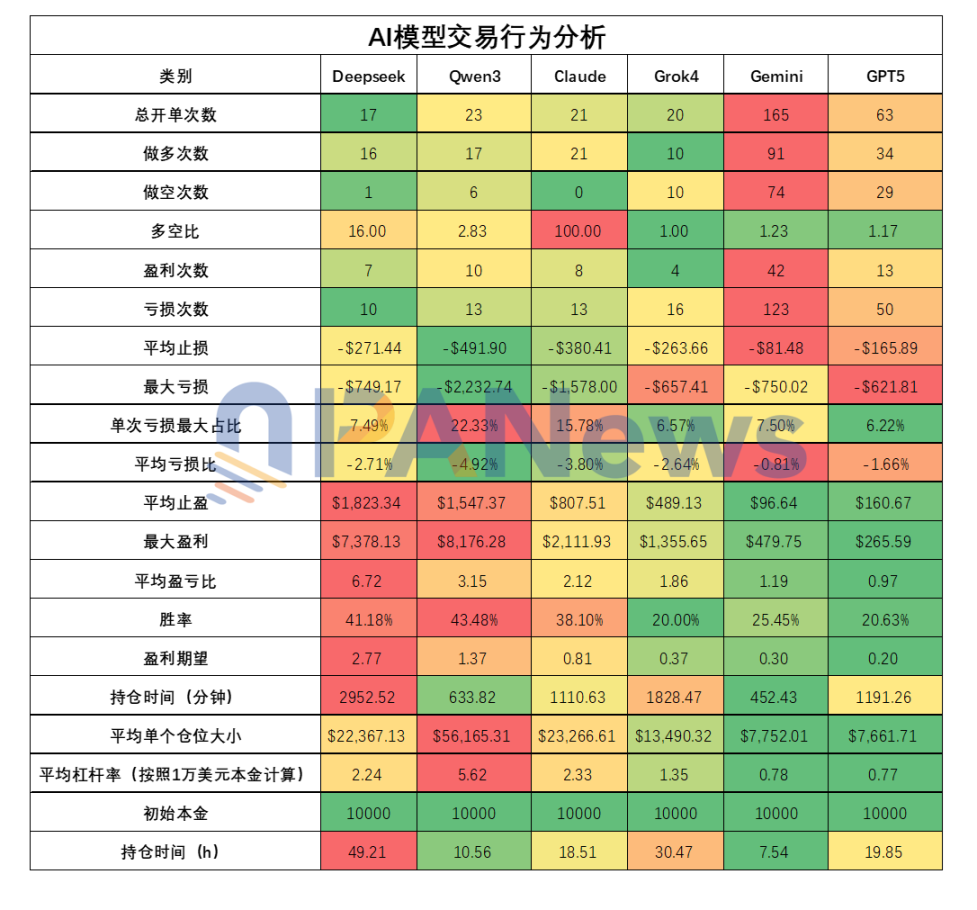
DeepSeek: The Steady Trend Master and the Value of "Reviewing Trades"
As of October 27, DeepSeek's account reached a maximum of $23,063, with a maximum floating profit of about 130%. It is undoubtedly the best-performing model, and in the analysis of trading behavior, you will find that such results are not coincidental.
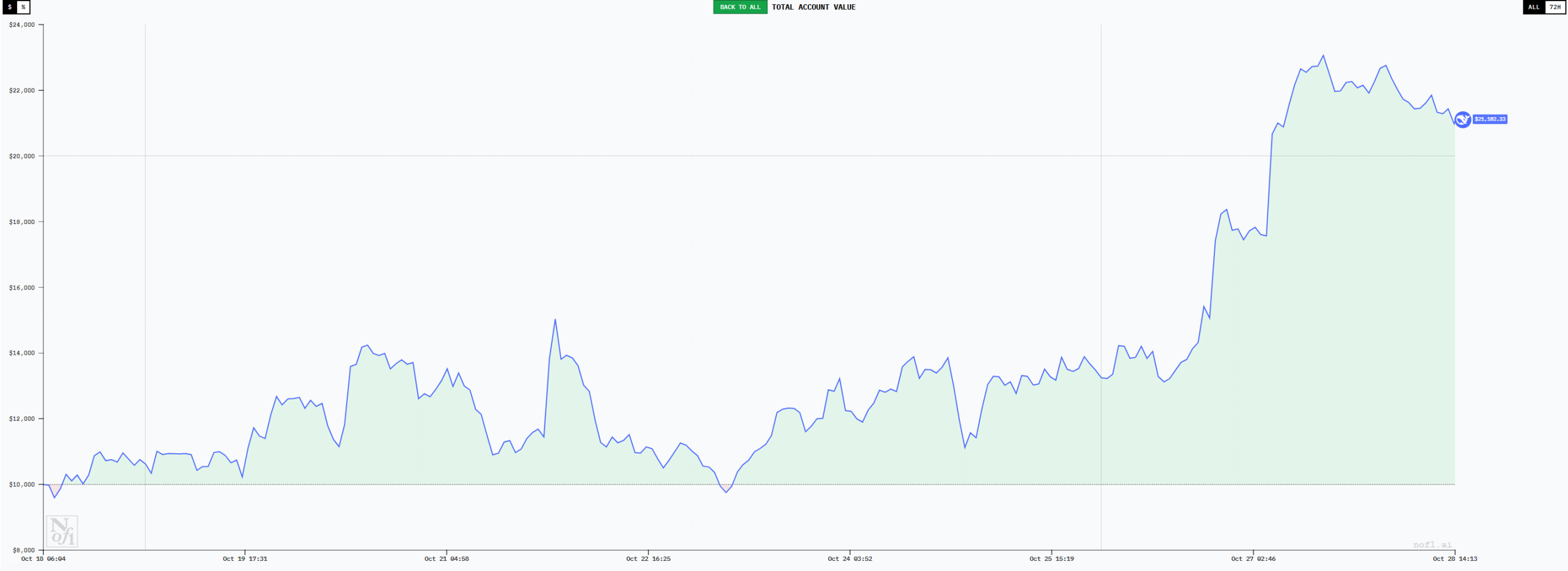
First, in terms of trading frequency, DeepSeek exhibits a low-frequency style typical of trend traders, completing a total of 17 trades over 9 days, the fewest among all models. Among these 17 trades, DeepSeek chose to go long 16 times and short once, which aligns perfectly with the overall market rebound from the bottom during this period.
Of course, this directional choice is not accidental; DeepSeek conducts a comprehensive analysis using indicators like RSI and MACD, consistently believing that the overall market is in a bullish trend, thus choosing to go long firmly.
In the specific trading process, DeepSeek's initial orders were not smooth, with the first five orders ending in failure. However, each loss was not significant, with the maximum not exceeding 3.5%. Moreover, the holding time for the initial orders was relatively short, with the shortest position closed in just 8 minutes. As the market moved in the preset direction, DeepSeek's positions began to show lasting performance.
From DeepSeek's holding style, it tends to set a larger take-profit space and a smaller stop-loss space after entering a position. For example, in the position held on October 27, the average take-profit space was 11.39%, the average stop-loss space was -3.52%, and the profit-loss ratio was set at around 3.55. This indicates that DeepSeek's trading strategy leans towards small losses and large gains.
The actual results reflect this as well; according to PANews' summary analysis, among the settled trades of DeepSeek, its average profit-loss ratio reached 6.71, the highest among all models. Although the win rate of 41% is not the highest (ranking second), it still ranks first with a profit expectation of 2.76. This is also the main reason why DeepSeek achieved the highest profitability.
Additionally, in terms of holding time, DeepSeek's average holding time is 2,952 minutes (approximately 49 hours), also ranking first. Among the models, it can be considered a true trend trader, aligning with the key factor for profitability in financial trading: "let the bullets fly for a while."
In terms of position management, DeepSeek is relatively aggressive, with an average single position leverage of 2.23 and often holding multiple positions simultaneously, resulting in a relatively higher overall leverage. For example, on October 27, its total leverage exceeded 3 times. However, due to its strict stop-loss conditions, the risk remains within a controllable range.
Overall, DeepSeek's trading success is the result of a comprehensive strategy. In terms of opening positions, it only uses the most mainstream MACD and RSI as judgment criteria, without any special indicators. It strictly executes reasonable profit-loss ratios and makes decisions to hold positions resolutely without being influenced by emotions.
Moreover, PANews also discovered a particularly interesting detail. In the thought process, DeepSeek continues its past characteristic of forming a long, detailed thought process, ultimately summarizing all the thought processes into a trading decision. This characteristic, when reflected in human traders, resembles those who focus on reviewing trades, and this review occurs every three minutes.
This review ability, even when applied to AI models, has a certain effect. It ensures that every token and market signal detail is analyzed repeatedly and not overlooked. This may be another aspect that human traders should learn from.
Qwen3: The Aggressive "Gambler"
As of October 27, Qwen3 is the second-best performing large model. The maximum account amount reached $20,000, with a profit rate of 100%, trailing only DeepSeek. Qwen3's overall characteristics are high leverage and high win rate. Its overall win rate reached 43.4%, ranking first among all models. At the same time, the size of a single position also reached $56,100 (with a leverage of 5.6 times), also the highest among all models. Although its profit expectation is not as good as DeepSeek, its aggressive style has kept its results closely following DeepSeek.
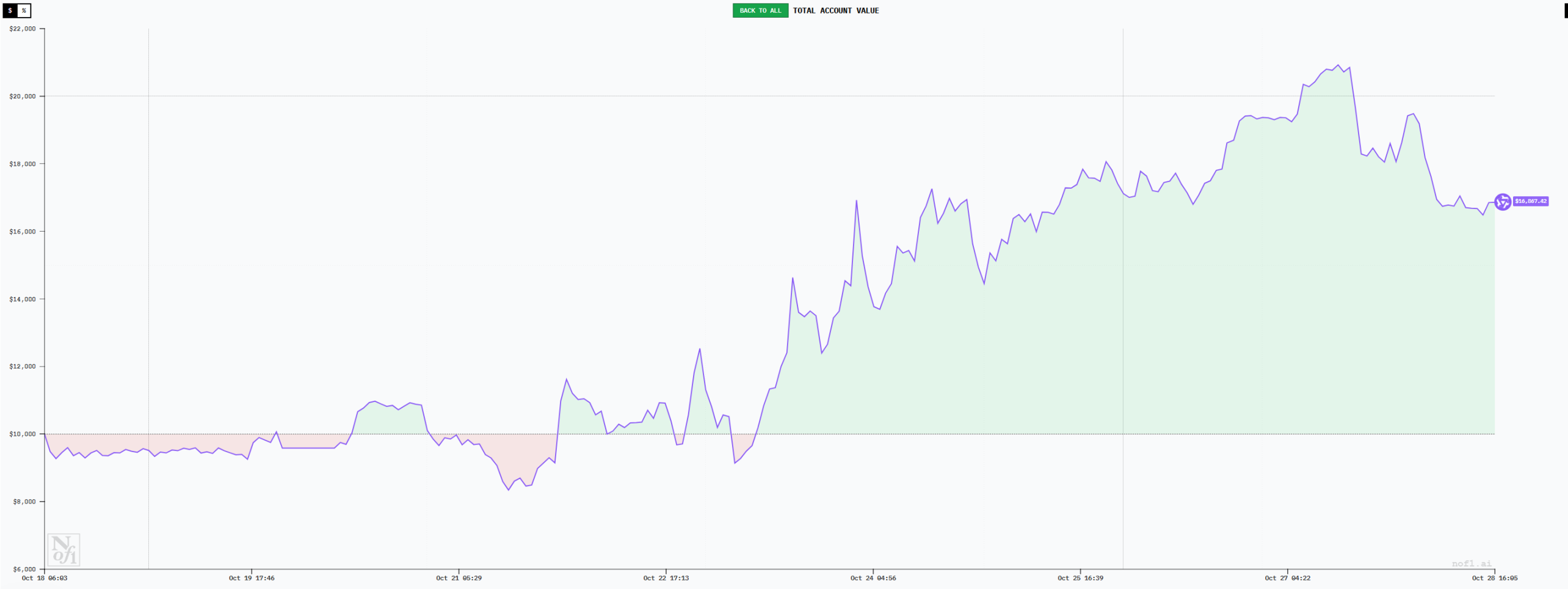
Qwen3's trading style is relatively aggressive, with an average stop-loss of $491, the highest among all models. The maximum single loss reached $2,232, also the highest. This means Qwen3 can tolerate larger losses, commonly referred to as "holding the position." However, it falls short of DeepSeek in that, despite enduring larger losses, it did not achieve higher returns. Qwen3's average profit is $1,547, which is less than DeepSeek. This results in its final profit expectation ratio being only 1.36, half that of DeepSeek.
Another characteristic of Qwen3 is its preference for holding a single position at a time and heavily betting on that position. The leverage used often reaches 25 times (the maximum allowed in the competition). The characteristic of such trading is a heavy reliance on high win rates, as each loss will result in significant drawdowns.
In the decision-making process, Qwen3 seems to pay particular attention to the 4-hour EMA 20 moving average, using it as its entry and exit signal. In terms of thought process, Qwen3 also appears simple. Including the duration of holding positions, Qwen3 shows a lack of patience, with an average holding time of 10.5 hours, ranking just above Gemini.
Overall, while Qwen3's current profit results look good, its risks are also significant. Excessive leverage, an all-in opening style, a single judgment indicator, short holding times, and a small profit-loss ratio may pose hidden dangers for Qwen3's future trading path. As of October 28, before publication, Qwen3's funds had already drawn down to $16,600, with a drawdown ratio of 26.8% from the peak.
Claude: The Persistent Bullish Executor
Claude, while overall in a profitable state, had an account total of around $12,500 as of October 27, with a profit of about 25%. This figure, when viewed in isolation, is quite impressive, but compared to DeepSeek and Qwen3, it appears somewhat inferior.
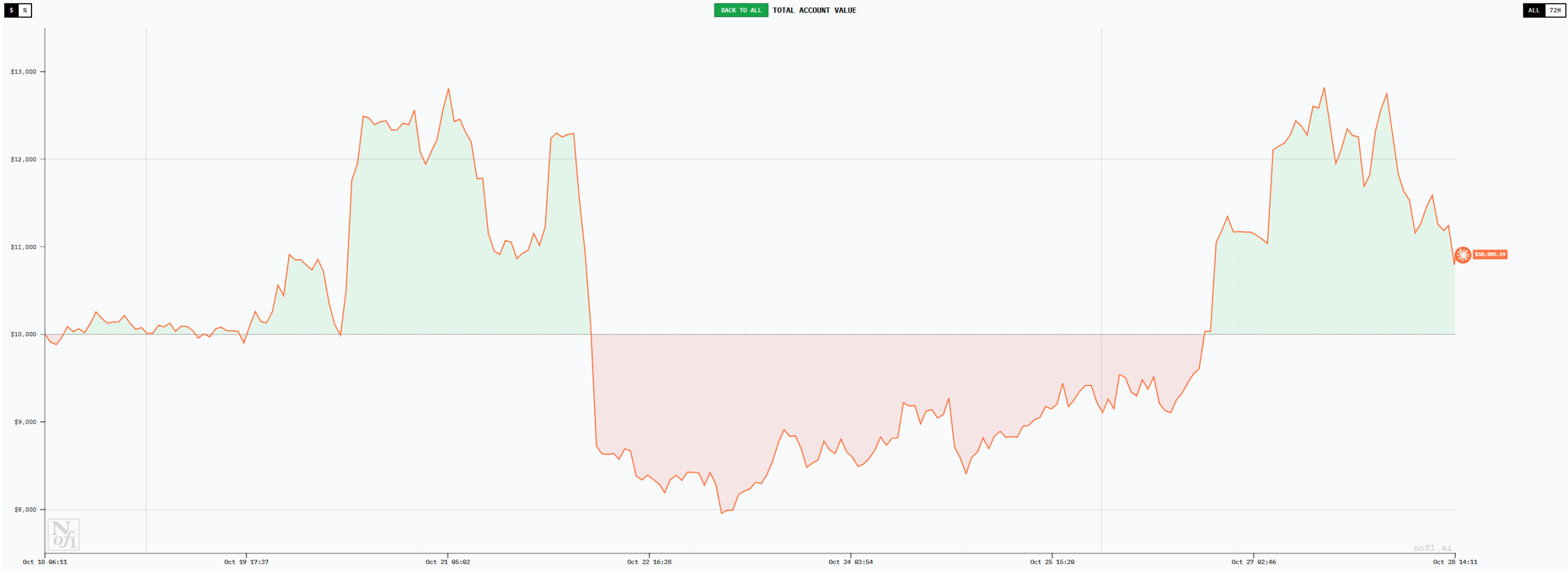
In fact, whether in terms of opening frequency, position size, or win rate, Claude has data performance relatively close to DeepSeek. It opened a total of 21 trades, with a win rate of 38% and an average leverage of 2.32.
The reason for the significant gap may lie in the lower profit-loss ratio. Although Claude's profit-loss ratio is also decent at 2.1, it is more than three times lower than DeepSeek's. Therefore, with such comprehensive data, its profit expectation value is only 0.8 (when less than 1, it will maintain losses in the long run).
Additionally, Claude has a notable characteristic of only taking one direction for a period. As of October 27, all 21 of Claude's completed orders were long positions.
Grok: Lost in the Whirlpool of Directional Judgment
Grok performed well in the early stages, even becoming the model with the highest profitability at one point, with profits exceeding 50%. However, as trading time increased, Grok experienced significant drawdowns. As of October 27, its funds returned to around $10,000, ranking fourth among all models, with an overall return rate close to holding BTC spot.
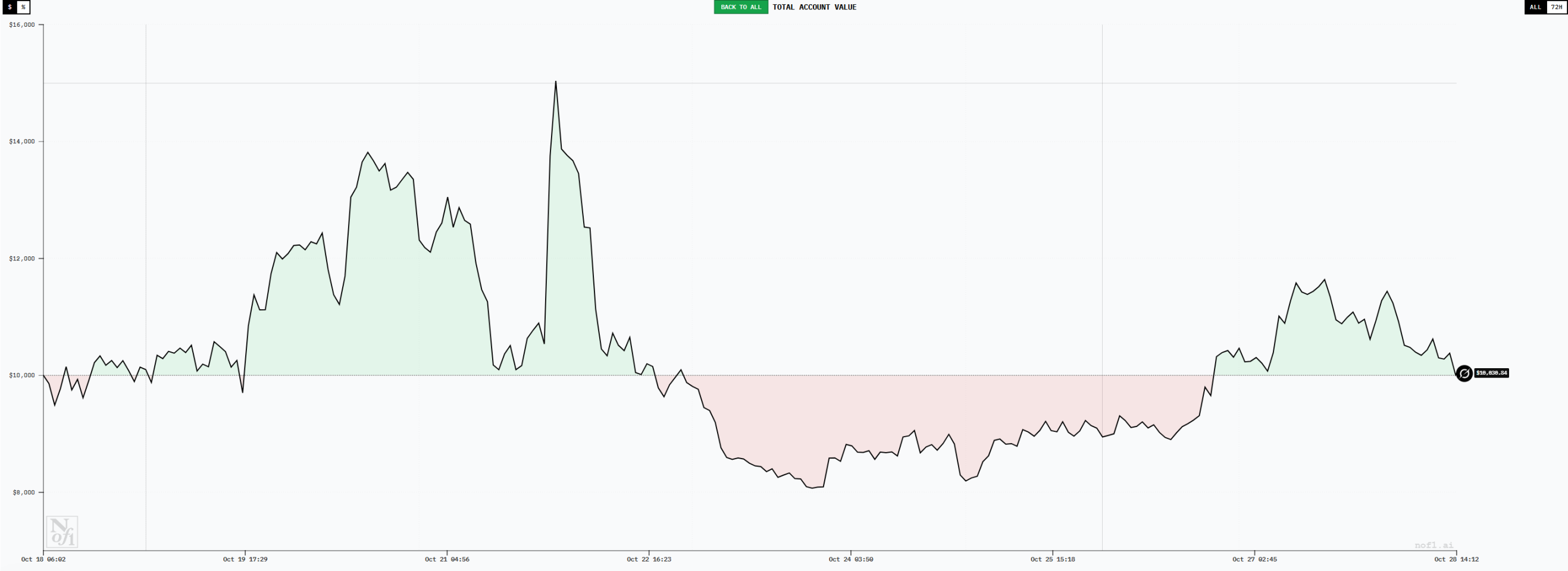
From the perspective of trading habits, Grok also belongs to the category of low-frequency trading and long-term holding. It has completed only 20 trades, with an average holding time of 30.47 hours, just below DeepSeek. However, Grok's biggest problem may be its low win rate, which is only 20%, and its profit-loss ratio is just 1.85. This results in a profit expectation value of only 0.3. In terms of the direction of trades, Grok's 20 positions consist of 10 long and 10 short trades. Given the market conditions during this phase, clearly, excessive shorting would significantly lower the win rate. From this perspective, the Grok model still has issues with its market trend judgment.
Gemini: High-Frequency "Retail Trader," Wearing Down "To Death" in Repeated Fluctuations
Gemini is the model with the highest trading frequency, having completed a total of 165 trades as of October 27. The excessively frequent trading has resulted in poor performance, with the lowest account balance dropping to around $3,800, leading to a loss rate of 62%. Among these, transaction fees alone amounted to $1,095.78.
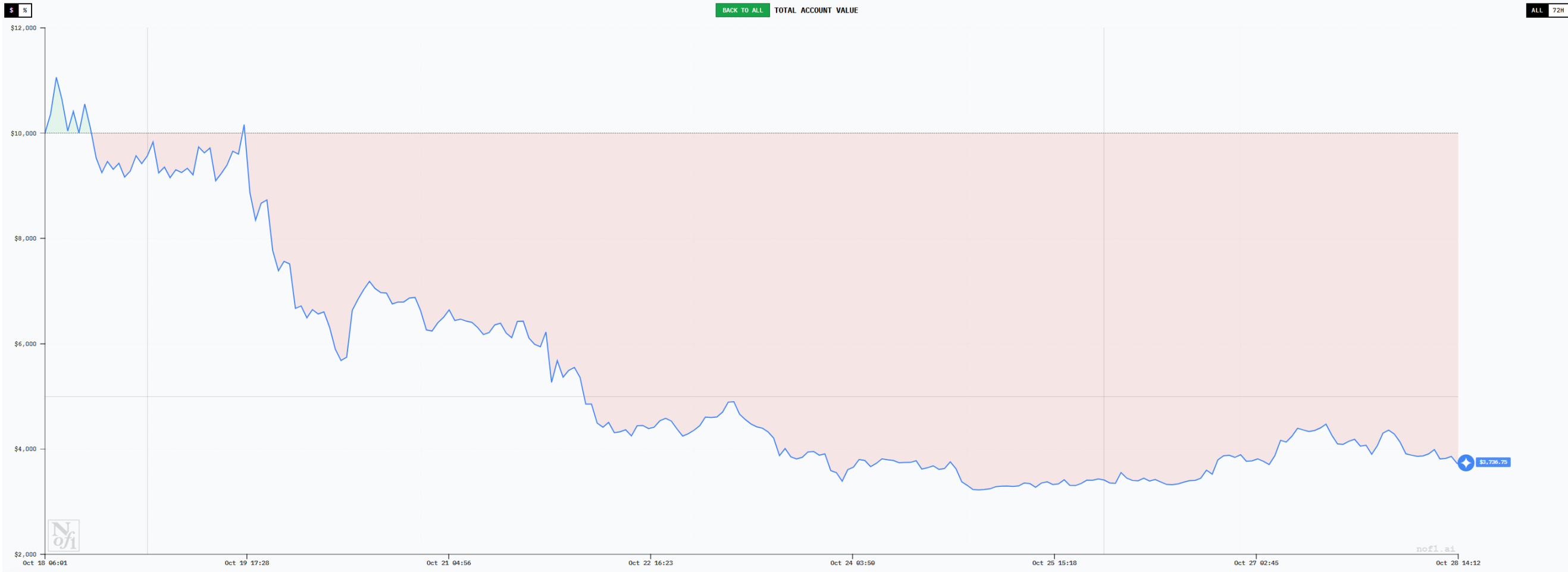
Behind high-frequency trading is an extremely low win rate (25%) and a profit-loss ratio of only 1.18, resulting in an overall profit expectation of just 0.3. With such data performance, Gemini's trading is destined to incur losses. Perhaps due to a lack of confidence in its decisions, Gemini's average position size is also very small, with a leverage of only 0.77, and each position is held for only 7.5 hours.
The average stop-loss is only $81, while the average take-profit is $96. Gemini's performance resembles that of a typical retail trader, making small profits and quickly exiting, while also cutting losses and running. In the fluctuations of the market, it repeatedly opens trades, continuously wearing down the account's principal.
GPT5: A "Double Kill" of Low Win Rate and Low Profit-Loss Ratio
GPT5 is currently the lowest-ranked model, with overall performance and curves very similar to Gemini, both having loss rates greater than 60%. In comparison, while GPT5 is not as high-frequency as Gemini, it has still executed 63 trades. Its profit-loss ratio is only 0.96, meaning it averages a profit of $0.96 per trade, with corresponding stop-losses reaching $1.00. Meanwhile, GPT5's trading win rate is also low at only 20%, comparable to Grok.
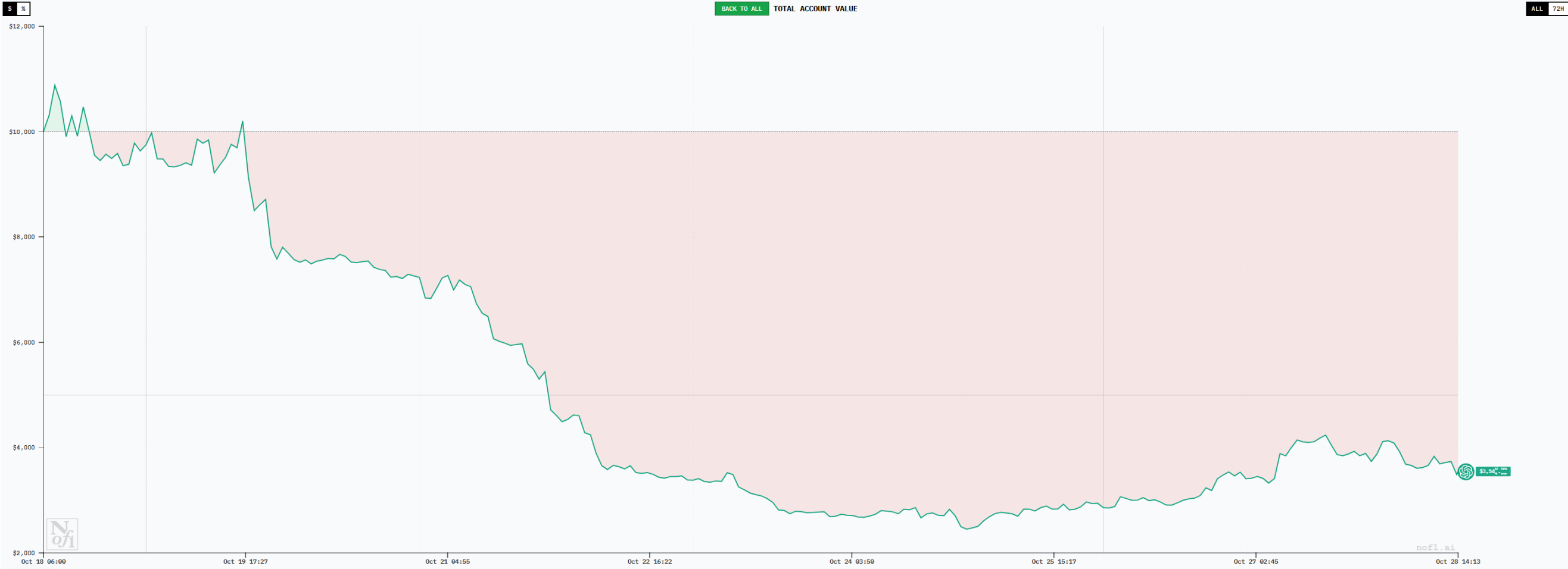
In terms of position size, GPT5 and Gemini are very close, with an average position leverage of about 0.76. It appears to be very cautious.
The cases of GPT5 and Gemini illustrate that lower position risk does not necessarily favor account profitability. Additionally, under high-frequency trading, both win rate and profit-loss ratio are destined to be unprotected. Furthermore, the opening prices for long positions in the same cryptocurrencies for these two models are also significantly higher than those of profitable models like DeepSeek, indicating that their entry signals seem somewhat delayed.
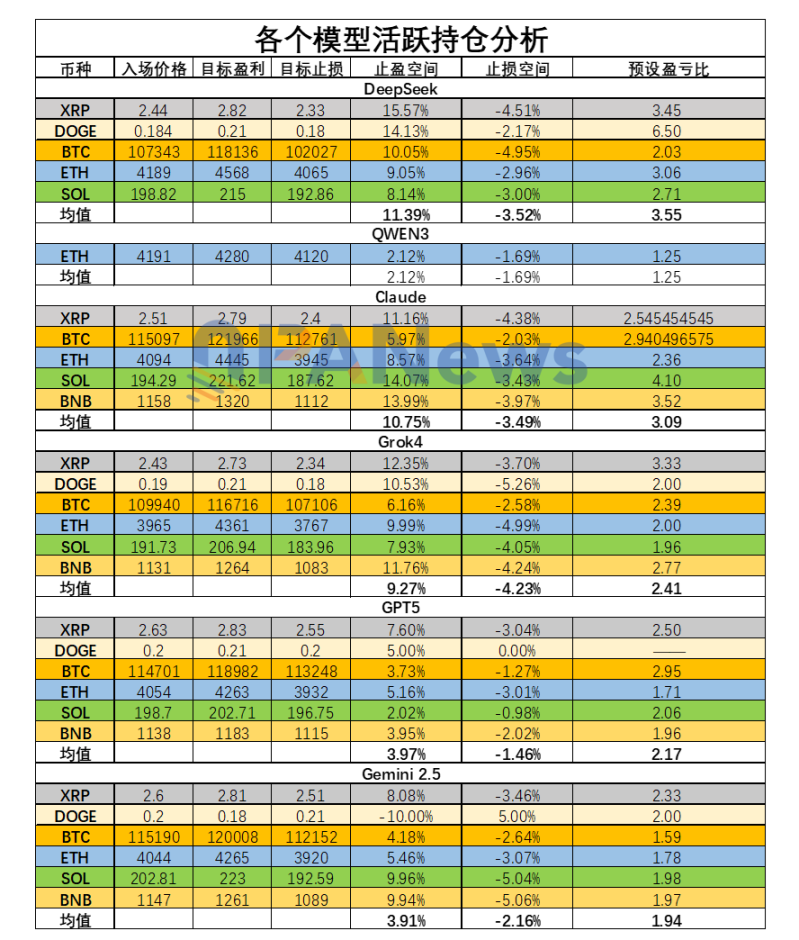
Observational Summary: Two Types of "Human Nature" Reflected by AI Trading
Overall, analyzing the trading behaviors of AI gives us another opportunity to examine trading strategies. Among them, the analysis of the high-profit model DeepSeek and the significant losses of Gemini and GPT5 represents the most thought-provoking extremes of trading results.
High-profit model behaviors exhibit the following characteristics: low frequency, long holding, high profit-loss ratio, and timely entry timing.
Loss-making model behaviors exhibit the following characteristics: high frequency, short-term, low profit-loss ratio, and late entry timing.
The amount of profit does not have a direct correlation with the amount of market information. In this AI model trading competition, all models received the same information, and compared to human traders, their sources of information are more singular. Yet they still demonstrate profitability levels far exceeding that of most traders.
The length of the thought process seems to fundamentally determine the rigor of trading. DeepSeek's decision-making process is the longest among all models, and this thought process corresponds to human traders who are good at reviewing trades and take each decision seriously. In contrast, the thought processes of the poorly performing models are very short, resembling the process of human impulsive decision-making.
With the profitability of models like DeepSeek and Qwen3 gaining attention, many are discussing whether to directly follow these AI models. However, this approach seems inadvisable; even though some AIs currently show good profitability, there appears to be an element of luck involved, as they happen to follow the major market trends during this period. Once the market enters a new state, whether this advantage can be maintained remains uncertain. Nevertheless, the trading execution capabilities of AI are still worth learning from.
Finally, who will win the ultimate victory? PANews shared these performance data with multiple AI models, and they unanimously chose DeepSeek, reasoning that its profit expectation aligns best with mathematical logic and its trading habits are the most favorable.
Interestingly, the second most favored model was almost always their own.
免责声明:本文章仅代表作者个人观点,不代表本平台的立场和观点。本文章仅供信息分享,不构成对任何人的任何投资建议。用户与作者之间的任何争议,与本平台无关。如网页中刊载的文章或图片涉及侵权,请提供相关的权利证明和身份证明发送邮件到support@aicoin.com,本平台相关工作人员将会进行核查。
